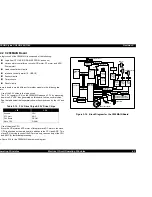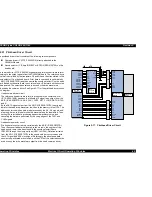
EPSON Stylus COLOR 860/1160
Revision C
Operating Principles
Overview
30
2.1.1.1 Printing Mechanism
The basic operating principles of the printhead, which plays a major role in
printing, are the same as previous models; ones that use a on-demand type U-
CHIP head method. (Refer to Figure1-1.)
Also, unlike the Stylus Color IIs, 820 and 200, the Stylus COLOR 860/1160 is
not an automatic correction type. So, in order to correct dispersion of multi
layer piezo electric element that drives each nozzle, you are required to input a
VH value written on the top surface of the printhead by using an exclusive
program when you replace the printhead, control board, or printer mechanism.
(Note there are no resistor arrays to determine the VH voltage on the main
control board.) Following explains printhead.
o
PZT
PZT is an abbreviation of Piezo Electric Element. Print signals from the
Main board are sent through the driver board on the printhead unit to the
PZT. Then, the PZT pushes the top cavity which has ink stored to
discharge the ink from each nozzle on the nozzle plate.
o
Cavity Set
The ink absorbed from the ink cartridge goes through the filter and then is
stored temporarily in this tank called “cavity” until PZT is driven.
o
Nozzle Plate
The board with nozzle holes on the printhead surface is called Nozzle
Plate.
o
Filter
When the ink cartridge is installed, if any dirt or dust around the cartridge
needle is absorbed into the head, there is a great possibility of causing
nozzle clog and disturbance of ink flow, and finally causing alignment
failure and dot missing. To prevent this problem, a filter is set below the
cartridge needle, where ink is filtered.
Figure 2-2. Printing Mechanism
Nozzle Selector Board
I/C Sensor Actuator
Needle
Ink Cartridge
Filter
Cavity
PZT
Nozzle Plate
Summary of Contents for Stylus COLOR 1160
Page 8: ...C H A P T E R PRODUCTDESCRIPTION ...
Page 28: ...C H A P T E R OPERATINGPRINCIPLES ...
Page 53: ...C H A P T E R TROUBLESHOOTING ...
Page 74: ...C H A P T E R DISASSEMBLYANDASSEMBLY ...
Page 116: ...C H A P T E R ADJUSTMENT ...
Page 150: ...C H A P T E R MAINTENANCE ...
Page 160: ...APPENDIX C H A P T E R ...
















































